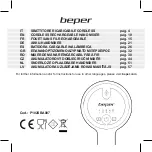
BGMFSB-S
ERIES
O
PERATION
& M
AINTENANCE
M
ANUAL
3389 ~ 128
th
Avenue Holland, MI 49424
Phone: 616/399-5600 Fax 616/399-3084
Copyright 2015 BRAWN Mixer, Inc.
www.BRAWNMIXER.com
Page 4 of 11
8
/6/2015
CAUTION
Repeated trial starts can overheat the motor and may
result in motor burnout. If repeated trial starts are made,
allow sufficient time between trials to permit heat to
dissipate from windings and rotor to prevent overheating.
Starting currents are several times running currents, and
heating varies as the square of the current.
After installation is completed, but before motor is put in
regular service, make an initial start as follows:
1. Check motor starting and control device
connections against wiring diagrams.
2. Check voltage, phase, and frequency of line circuit
(power supply) against motor nameplate.
3. If possible, remove external load (disconnect drive)
and turn shaft by hand to ensure free rotation. This
may have been done during installation procedure;
if so, and conditions have not changed since, this
check may not be necessary.
a. If drive is disconnected, run motor at no load
long enough to be certain that no unusual
conditions develop. Listen and feel for
excessive noise, vibration, clicking, or
pounding. If present, stop motor immediately.
Investigate the cause and correct before
putting motor in service.
b. If drive is not disconnected, interrupt the
starting cycle after motor has accelerated to
low speed. Carefully observe for unusual
conditions as motor coasts to a stop.
4. When checks are satisfactory, operate at minimum
load and look for unusual condition. Increase load
slowly to maximum. Check unit for satisfactory
operation.
CAUTION
Guard against overloading. Overloading causes
overheating and overheating means shortened insulation
life. A motor subjected to a 10°C temperature rise above
the maximum limit for the insulation may cause the
insulation life to be reduced by 50%. To avoid
overloading, be sure motor current does not exceed
nameplate current when nameplate voltage is applied
.
Electric motors operating under normal conditions
become quite warm. Although some places may feel hot
to the touch, the unit may be operational within limits.
Use a thermocouple to measure winding temperature.
The total temperature, not the temperature rise, is the
measure of safe operation. Investigate the operating
conditions if the total temperature measured by a
thermocouple placed on the windings exceeds:
230°F (110°C) for class “B” insulation
275°F (135°C) for class “F” insulation
302°F (150°C) for class “H” insulation
VOLTAGE REGULATION
Motors will operate successfully under the following
conditions of voltage and frequency variation, but not
necessarily in accordance with the standard established
for operation under rated conditions:
1. When the variation in voltage does not exceed
10% above or below normal, with all phases
balanced.
2. When the variation in frequency does not exceed
5% above or below normal.
3. When the sum of the voltage and frequency of the
voltage does not exceed 10% above or below
normal (provided the frequency variation does not
exceed 5%).
MAINTENANCE
Failure to properly maintain the equipment can result in
severe personal injury and product failure. The
instructions contained herein should be carefully
reviewed, understood and followed. The following
maintenance procedures should be performed regularly:
1. Bearing lubrication (When regreaseable bearings
are supplied)
2. Insulation resistance check
3. Cleaning
Summary of Contents for BGMF100
Page 1: ...BGMF SB SERIES...
Page 2: ......
Page 4: ......
Page 5: ......
Page 6: ......
Page 8: ......
Page 23: ...THIS PAGE IS INTENTIONALLY LEFT BLANK...
Page 24: ...THIS PAGE IS INTENTIONALLY LEFT BLANK...












































